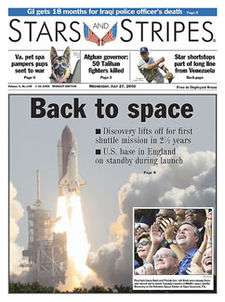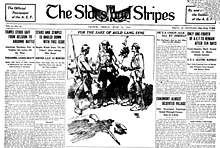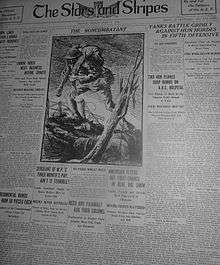Stars and Stripes (newspaper)
Stars and Stripes is an American military newspaper that focuses and reports on matters concerning the members of the United States Armed Forces. It operates from inside the Department of Defense, but is editorially separate from it, and its First Amendment protection is safeguarded by the United States Congress, to whom an independent ombudsman, who serves the readers' interests, regularly reports. As well as a website, Stars and Stripes publishes four daily print editions for the military service members serving overseas; these European, Middle Eastern, Japanese, and South Korean editions are also available as free downloads in electronic format, and there are also seven digital editions.[1] The newspaper has its headquarters in Washington, D.C.[2]
 The July 27, 2005 front page of Stars and Stripes (Middle East Edition) | |
| Type | Daily newspaper |
|---|---|
| Format | Tabloid |
| Owner(s) | Defense Media Activity |
| Publisher | National Tribune Corporation |
| Founded | 1861 |
| Language | American English |
| Headquarters | National Press Building Washington, D.C., U.S. |
| ISSN | 0894-8542 |
| OCLC number | 8777119 |
| Website | www.Stripes.com |
History
Creation
On November 9, 1861, during the Civil War, soldiers of the 11th, 18th, and 29th Illinois Regiments set up camp in the Missouri city of Bloomfield. Finding the local newspaper's office empty, they decided to print a newspaper about their activities. They called it the Stars and Stripes. Today, the Stars and Stripes Museum/Library Association is located in Bloomfield.[3] There is, however, no continuity between this and the later newspaper bearing the same name.
World War I


During World War I, the staff, roving reporters, and illustrators of the Stars and Stripes were veteran reporters or young soldiers who would later become such in the post-war years. It was published by the American Expeditionary Forces (AEF) from February 8, 1918, to June 13, 1919.[4] Harold Ross, editor of the Stars and Stripes, returned home to found The New Yorker magazine. Cyrus Baldridge, its art director and principal illustrator, became a major illustrator of books and magazines, as well as a writer, print maker and stage designer. Sports page editor Grantland Rice had a long career in journalism and founded a motion picture studio called Grantland Rice Sportlight.[5] Drama critic Alexander Woollcott's essays for Stars and Stripes were collected in his 1919 book, The Command Is Forward.
The Stars and Stripes was then an eight-page weekly which reached a peak of 526,000 readers, relying on the improvisational efforts of its staff to get it printed in France and distributed to U.S. troops.
World War II

During World War II, the newspaper was printed in dozens of editions in several operating theaters. Again, both newspapermen in uniform and young soldiers, some of whom would later become important journalists, filled the staffs and showed zeal and talent in publishing and delivering the paper on time. Some of the editions were assembled and printed very close to the front in order to get the latest information to the most troops. Also, during the war, the newspaper published the 53-book series G.I. Stories.
After Bill Mauldin did his popular "Up Front" cartoons for the World War II Stars and Stripes, he returned home to a successful career as an editorial cartoonist and two-time winner of the Pulitzer Prize.
The magazine frequently posted photographs of a young Marilyn Monroe, then known as Norma Jeane Dougherty which later led her as being named 'Miss Cheesecake 1952' by "Stars & Stripes" magazine[6]
Former staffers
The newspaper has been published continuously in Europe since 1942 and in the Pacific since 1945.
Notable former Stars and Stripes staffers include: CBS 60 Minutes' Andy Rooney and Steve Kroft; songwriter and author Shel Silverstein; comic book illustrator Tom Sutton; authors Gustav Hasford and Ralph G. Martin; painter and cartoonist Paul Fontaine; author and television news correspondent Tony Zappone; cartoonist Vernon Grant (A Monster Is Loose in Tokyo); Hollywood photographer Phil Stern; and stock market reporter and host of public television's Wall Street Week, Louis Rukeyser, and the first and only Black reporter in WWII, Allen Morrison.
A photograph in Stars and Stripes loosely inspired the exploits of PFC Jack Agnew in the 1965 novel and its 1967 film adaptation, The Dirty Dozen.
American comic strips have been presented in a 15-page section, Stripes' Sunday Comics.
Current

Stars and Stripes is authorized by Congress and the US Department of Defense to produce independent daily military news and information distributed at U.S. military installations in Europe and Mideast and East Asia. A weekly derivative product is distributed within the United States by its commercial publishing partners. Stars and Stripes newspaper averages 32 pages each day and is published in tabloid format and online at www.stripes.com/epaper. Stars and Stripes employs civilian reporters, and U.S. military senior non-commissioned officers as reporters, at a number of locations around the world and on any given day has an audience just shy of 1.0 million. Stars and Stripes also serves independent military news and information to an online audience of about 2.0 million unique visitors per month, 60 to 70 percent of whom are located in the United States.
Stars and Stripes is a non-appropriated fund (NAF) organization, only partially subsidized by the Department of Defense. In 2020, Deputy Under Secretary of Defense Elaine McCusker indicated its funding would be cut and said: “We have essentially decided that, you know, kind of coming into the modern age that newspaper is probably not the best way that we communicate any longer.”[7] A large portion of its operating costs is earned through the sale of advertising and subscriptions. Unique among the many military publications, Stars and Stripes operates as a First Amendment newspaper and is part of the newly formed Defense Media Activity. The other entities encompassed by the Defense Media Activity (the DoD News Channel and Armed Forces Radio and Television Service, for example), are command publications of the Department of Defense; only Stars and Stripes maintains complete editorial independence.
Stars and Stripes is in the process of digitizing its World War II editions. Newspaper microfilm from 1949 to 1999 is now in searchable format through a partnership with Heritage Microfilm and has been integrated into an archives website. Newspaper Archive has also more recently made the England, Ireland and Mediterranean editions from World War II available.
In February 2020, President Donald Trump's administration proposed completely eliminating the newspaper's federal support in 2021. The amount is more than $15 million a year, which represents approximately half the publication's budget. It was described by the Stars and Stripes ombudsman as "a fatal cut.”[8]
See also
References
- "Site Map". Stripes. Retrieved February 27, 2013.
- "Contact Us Archived September 29, 2010, at the Wayback Machine." Stars and Stripes. Retrieved on October 12, 2010. "529 14th Street NW, Suite 350, Washington, D.C. 20045-1301."
- "Starsandstripesmuseumlibrary". Starsandstripesmuseumlibrary. Retrieved February 27, 2013.
- Library of Congress 2018
- "1918-1919: A Talented Editorial Staff", The Stars and Stripes, Library of Congress Serial and Government Publications Division., retrieved April 25, 2017
- Banner, Lois (2012). Marilyn: The Passion and the Paradox.
- Jones, Tom (February 11, 2020). "Bad news for Big Bird? » Stars and Stripes faces threat » WSJ hits high mark". Poynter. Retrieved March 1, 2020.
- The Washington Post, "The Stars and Stripes newspaper has long supported the troops. Now it needs Congress’s support."June 22, 2020
- Library of Congress (2018). "Stars and Stripes: The American Soldiers' Newspaper of World War I, 1918 to 1919". Library of Congress. Retrieved February 7, 2018.CS1 maint: ref=harv (link)
External links
| Wikimedia Commons has media related to Stars and Stripes (newspaper). |
- Official website
- Today's Stars and Stripes Mideast Edition front page at the Newseum website
- Stars and Stripes multimedia gallery
- Stars and Stripes Museum/Library Association, Inc.
- Stars and Stripes: The American Soldiers' Newspaper of World War I, 1918 to 1919
- The short film The Story of Stars and Stripes is available for free download at the Internet Archive
- The short film Big Picture: All the World to All the Troops is available for free download at the Internet Archive